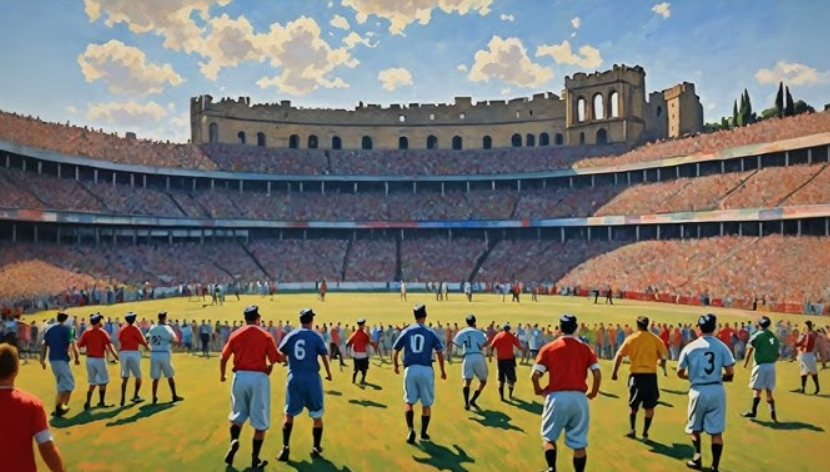The Evolution of Sports: From Ancient Games to Modern Competitions

Introduction to the Evolution of Sports
Sports have been an integral part of human culture and society for thousands of years. From the earliest physical activities of ancient humans to the grand, global competitions we witness today, sports have evolved dramatically. They serve not only as a form of entertainment but also as a reflection of societal values, cultural identity, and human ambition. Understanding the evolution of sports sheds light on how these activities shaped civilizations and continue to unite people worldwide.
Origins of Ancient Sports and Games
Long before organized sports existed, prehistoric humans engaged in physical contests for survival skills like hunting, fighting, and endurance. These activities gradually transformed into competitive games, reflecting a basic human desire for challenge and camaraderie.
See also: sportsfanfarecom
Early Competitive Games
Ancient civilizations such as Egypt, Mesopotamia, and the Indus Valley developed some of the earliest documented games. In Egypt, sports were often linked to religious festivals, including swimming and wrestling competitions. Meanwhile, the Sumerians of Mesopotamia organized contests that tested strength and agility, laying the groundwork for competitive sports.
Sports in Ancient Greece: Birth of Organized Competitions
Ancient Greece is often credited with formalizing sports as structured competitions, most famously through the Olympic Games, which began in 776 BCE. These games brought together city-states in peaceful rivalry, promoting ideals of physical excellence and fair competition.
The Olympic Games and Their Cultural Significance
Held every four years in Olympia, the Olympic Games featured events like running, wrestling, boxing, and chariot racing. These contests were deeply intertwined with religious worship and were seen as a way to honor the gods, particularly Zeus. The Olympics inspired future generations to value athleticism and honor.
Influence of Greek Philosophy on Sportsmanship
Greek philosophers emphasized virtues like fairness, honor, and discipline in sport. Physical education was central to Greek life, especially in training young men for citizenship and military service. This philosophy laid the foundation for the concept of sportsmanship that persists today.
Roman Contributions to Sports and Spectacles
The Romans inherited much from the Greeks but added their flair for grandeur and spectacle. Gladiatorial games and chariot races became major public entertainments, held in massive arenas like the Colosseum.
Impact on Modern Sports Infrastructure
Roman innovations in stadium design, crowd control, and event management influenced how sports facilities are built today. The concept of large-scale spectator sports and professional athletes can trace roots back to Rome.
Sports in Asia: Traditional Games and Martial Arts
Across Asia, ancient societies developed unique sports and martial arts deeply connected to their cultures. In China, games like archery and cuju (an early form of football) were popular, while India fostered wrestling and chariot racing as part of traditional sports.
Martial Arts as a Form of Sport and Discipline
Martial arts such as karate, judo, and kung fu evolved not only as fighting techniques but also as disciplined sports emphasizing respect, control, and physical conditioning. These arts remain globally popular today.
Medieval and Renaissance Sports in Europe
During the Middle Ages, many sports emerged from combat training and aristocratic leisure. Jousting tournaments and archery contests were common, often tied to festivals and social hierarchy.
Transition from Combat to Organized Sports
While initially practical for warfare, many medieval sports gradually became spectator events. Hunting and falconry also evolved into competitive activities, reflecting changes in society and culture.
The Rise of Modern Sports (18th – 19th Century)
The Industrial Revolution brought major social changes, including urbanization and more leisure time, which fueled the formal codification of sports rules. Clubs and associations were established, shaping modern versions of football, cricket, rugby, and tennis.
The Role of the Industrial Revolution
With improved transportation and communication, sports spread quickly. Mass media, including newspapers and later radio, made sports accessible to larger audiences, increasing their popularity.
The Modern Olympic Games: Revival and Global Expansion
In 1896, Pierre de Coubertin revived the Olympic Games, inspired by ancient Greek ideals. The modern Olympics quickly became a symbol of international unity and athletic excellence.
Inclusion of Women and Paralympic Sports
Over time, the Olympics expanded to include women and athletes with disabilities, reflecting progress toward inclusivity and equality. The Paralympics showcase the athletic prowess of differently-abled competitors worldwide.
Professionalization and Commercialization of Sports in the 20th Century
The 20th century saw sports transition into full-fledged professions. Leagues formed, sponsorships increased, and broadcasting rights became lucrative, transforming sports into a multi-billion-dollar industry.
Impact of Globalization on Sports
Global tournaments such as the FIFA World Cup and the NBA Finals highlight the worldwide appeal of sports. Cultural exchanges through sports promote mutual understanding and global cooperation.
Technological Innovations in Modern Sports
Advances in technology have transformed how sports are played, officiated, and consumed. Video assistant referees (VAR), instant replays, and wearable tech help improve fairness and performance.
Digital Media and Fan Engagement
Social media platforms connect athletes and fans, creating interactive experiences. Esports, virtual reality, and augmented reality open new frontiers for competition and entertainment.
Challenges and Controversies in Modern Sports
Despite progress, sports face ongoing challenges like doping scandals, ethical dilemmas, and the impact of commercialization on athlete well-being.
The Future of Sports: Trends and Predictions
Sustainability, inclusivity, and emerging sports trends are shaping the future landscape. Environmental concerns push for greener sports practices, while technology continues to innovate.
Frequently Asked Questions (FAQs)
- How did ancient sports influence modern games?
Ancient sports laid the foundational rules, values, and formats that have evolved into modern competitions. - What was the significance of the Olympic Games?
The Olympics fostered unity, honor, and the celebration of human physical potential. - How has technology changed sports?
Technology has improved fairness, performance tracking, and fan engagement. - What are some traditional sports still played today?
Wrestling, archery, martial arts, and traditional football forms continue globally. - How does globalization affect sports?
It increases cultural exchange, broadens audiences, and creates international tournaments. - What is the future outlook for sports?
The future includes greater inclusivity, sustainability, and technological integration.
Conclusion
The evolution of sports from ancient games to modern competitions reflects humanity’s enduring passion for physical challenge, community, and excellence. Through centuries of change, sports continue to inspire, entertain, and unite people around the world, proving that the spirit of competition is truly timeless.

